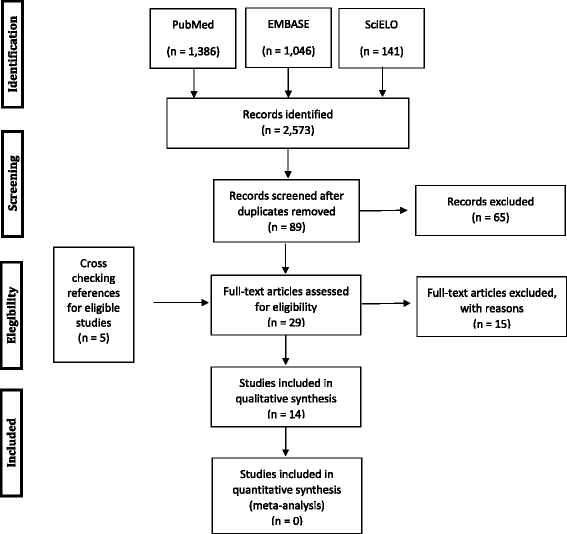Sexual life and dysfunction after maternal morbidity: a systematic review
- PMID: 26596506
- PMCID: PMC4657322
- DOI: 10.1186/s12884-015-0742-6
Sexual life and dysfunction after maternal morbidity: a systematic review
Abstract
Background: Because there is a lack of knowledge on the long-term consequences of maternal morbidity/near miss episodes on women's sexual life and function we conducted a systematic review with the purpose of identifying the available evidence on any sexual impairment associated with complications from pregnancy and childbirth.
Methods: Systematic review on aspects of women sexual life after any maternal morbidity and/or maternal near miss, during different time periods after delivery. The search was carried out until May 22(nd), 2015 including studies published from 1995 to 2015. No language or study design restrictions were applied. Maternal morbidity as exposure was split into general or severe/near miss. Female sexual outcomes evaluated were dyspareunia, Female Sexual Function Index (FSFI) scores and time to resume sexual activity after childbirth. Qualitative syntheses for outcomes were provided whenever possible.
Results: A total of 2,573 studies were initially identified, and 14 were included for analysis after standard selection procedures for systematic review. General morbidity was mainly related to major perineal injury (3(rd) or 4(th) degree laceration, 12 studies). A clear pattern for severity evaluation of maternal morbidity could not be distinguished, unless when a maternal near miss concept was used. Women experiencing maternal morbidity had more frequently dyspareunia and resumed sexual activity later, when compared to women without morbidity. There were no differences in FSFI scores between groups. Meta-analysis could not be performed, since included studies were too heterogeneous regarding study design, evaluation of exposure and/or outcome and time span.
Conclusion: Investigation of long-term repercussions on women's sexual life aspects after maternal morbidity has been scarcely performed, however indicating worse outcomes for those experiencing morbidity. Further standardized evaluation of these conditions among maternal morbidity survivors may provide relevant information for clinical follow-up and reproductive planning for women.
Figures
References
-
- Souza JP, Say L, Pattinson RC, Gulmezoglu AM. Evaluating the quality of care for severe pregnancy complications The WHO near-miss approach for maternal health. WHO, 2011. Available at http://whqlibdoc.who.int/publications/2011/9789241502221_eng.pdf.
-
- Pacagnella RC, Cecatti JG, Camargo RP, Silveira C, Zanardi DT, Souza JP, et al. Rationale for a long-term evaluation of the consequences of potentially life-threatening maternal conditions and maternal ‘near-miss’ incidents using a multidimensional approach. J Obstet Gynaecol Can. 2010;32(8):730–738. - PubMed
Publication types
MeSH terms
Grants and funding
LinkOut - more resources
Full Text Sources
Other Literature Sources
Medical
Miscellaneous


